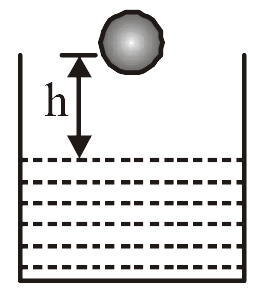A small spherical ball of radius 0.1 mm and density 104 kg m−3 falls freely under gravity through a distance h before entering a tank of water. If, after entering the water the velocity of ball does not change and it continue to fall with same constant velocity inside water, then the value of h will be _____m (Given g=10ms−2, viscosity of water =1.0×10−5N−sm−2)
To solve the problem, we will follow these steps:
Step 1: Determine the velocity of the ball just before it enters the water.
The ball falls freely under gravity through a distance h. The velocity v of the ball just before entering the water can be calculated using the equation for free fall:
v=√2gh
where g=10m/s2.
Step 2: Set up the equation for terminal velocity.
When the ball enters the water, it reaches a constant velocity (terminal velocity). The terminal velocity vt for a sphere falling through a fluid is given by:
vt=29⋅r2(ρb−ρw)gη
where:
- r is the radius of the ball,
- ρb is the density of the ball,
- ρw is the density of the water,
- g is the acceleration due to gravity,
- η is the viscosity of water.
Step 3: Substitute known values into the terminal velocity equation.
Given:
- Radius r=0.1mm=0.1×10−3m=1.0×10−4m
- Density of the ball ρb=104kg/m3
- Density of water ρw=103kg/m3
- Viscosity η=1.0×10−5N s/m2
Substituting these values into the terminal velocity equation:
vt=29⋅(1.0×10−4)2(104−103)⋅101.0×10−5
Step 4: Simplify the terminal velocity equation.
Calculating the components:
1. (1.0×10−4)2=1.0×10−8
2. (104−103)=9000
3. Therefore, the equation becomes:
vt=29⋅1.0×10−8⋅9000⋅101.0×10−5
Step 5: Calculate vt.
Now, simplifying further:
vt=2⋅9000⋅10⋅1.0×10−89⋅1.0×10−5=180000×10−89×10−5=1800009×10−3=20000×10−3=20m/s
Step 6: Set the two expressions for velocity equal.
Since the velocity of the ball just before entering the water equals the terminal velocity, we have:
√2gh=20
Step 7: Solve for h.
Squaring both sides:
2gh=400
Now, substituting g=10m/s2:
2⋅10⋅h=400⟹20h=400⟹h=40020=20m
Final Answer:
The value of h is 20m.
---
The ball falls freely under gravity through a distance h. The velocity v of the ball just before entering the water can be calculated using the equation for free fall:
When the ball enters the water, it reaches a constant velocity (terminal velocity). The terminal velocity vt for a sphere falling through a fluid is given by:
- r is the radius of the ball,
- ρb is the density of the ball,
- ρw is the density of the water,
- g is the acceleration due to gravity,
- η is the viscosity of water.
Given:
- Radius r=0.1mm=0.1×10−3m=1.0×10−4m
- Density of the ball ρb=104kg/m3
- Density of water ρw=103kg/m3
- Viscosity η=1.0×10−5N s/m2
Calculating the components:
2. (104−103)=9000
3. Therefore, the equation becomes:
Now, simplifying further:
Since the velocity of the ball just before entering the water equals the terminal velocity, we have:
Squaring both sides:
The value of h is 20m.
Similar Questions
A spherical ball of radius 3.0×10−4m and density 104kg/m3 falls freely under gravity through a distance h before entering a tank of water. If after entering the water the velocity of the ball does not change, find h. Viscosity of water is 9.8×106N−s/m2.
View SolutionA spherical ball of radius 3×10−4m and density 104kg/m3 falls freely under gravity through a distance h before entering a tank of water. If after entering the water the velocity of the ball does not change, find h the viscosity of water is 9.8×10−6N−s/m2
View Solution
Knowledge Check
- Question 1 - Select One
A metal ball ofradius 10−4 m and density 104kg/m3 falls freely under gravity through a distance 'h' and enters a tank of water. It is found that after entering the water, the velocity of ball does not change. What is the value of h?
[ηfor water 10−5 Pas ,g=10m/s2 and orhwater=103kg/m3]A10mB15mC18mD20m - Question 2 - Select One
A small steel ball of mass m and radius r is falling under gravity through a viscous liquid of coefficient of viscosity η. If g is the value of acceleration due to gravity. Then the terminal velocity of the ball is proportional to (ignore buoyancy)
Amg(η)rBmg(η)rCmgrηDmgrη
A small ball of radius 'r' falls freely under gravity through a distance 'h' before entering a tank of water. If after entering the water, the velocity of ball does not change, the 'h' is proportional to
View SolutionA small ball of radius 'r' falls freely under gravity through a distance 'h' before entering a tank of water. If after entering the water, the velocity of ball does not change, the 'h' is proportional to
View SolutionA spherical ball of radius 3.0×10−4 m and density 104kgm3 falls freely under gravity through a distance H=n×500m before entering a tank of water. If after enerting the water the velocity of the ball does not change, then find n. viscosity of water is 10×10−6N−sm2,g=10ms
View SolutionA ball of radius r and density r falls freely under gravity through a distance h before entering water. Velocity of ball does not change even on entering water. If viscosity of water is η the value of h is given by
 View Solution
View SolutionIn an experiment to verify Stokes law , a small spherical ball of radius r and density ρ falls under gracvity throught a distance h in air before entering a tank of wate . If the terminal velocity of the ball inside water is same as its velocity just befor entering the water surface , then the value of h is proportional to : ( ignore viscosity of air ) .
View SolutionA metallic sphere of radius 1.0×10−3m and density 1.0×104kg/m3 enters a tank of water, after a free fall through a distance of h in the earth's gravitational field. If its velocity remains unchanged after entering water, determine the value of h. Given: coefficient of viscosity of water =1.0×10−3Ns/m2,g=10ms−12 and density of water =1.0×103kg/m3.
View Solution

